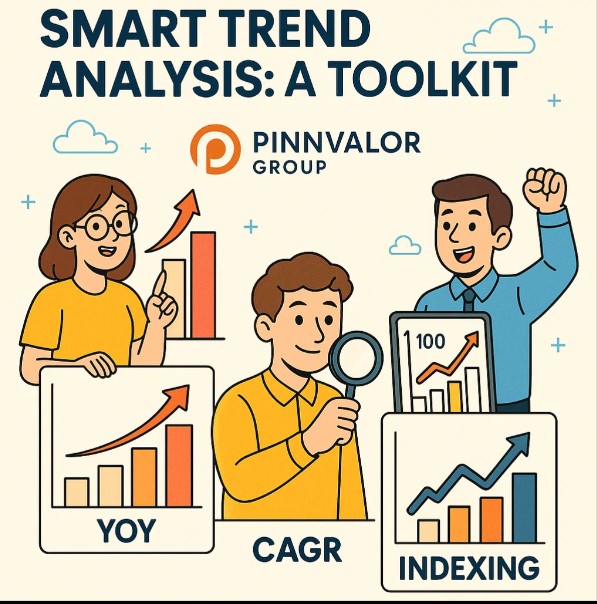
Smart Trend Analysis: A Toolkit with YOY, CAGR, and Indexing Explained
In today’s data-driven world, businesses and investors rely heavily on trend analysis to make informed decisions. Whether it's measuring financial growth, market performance, or operational efficiency, trend indicators such as Year-over-Year (YOY), Compound Annual Growth Rate (CAGR), and Index Analysis are indispensable tools in your analytical toolkit.
Are your numbers just growing, or are they telling a story?
YOY shows the heartbeat, CAGR reveals the rhythm, and Indexing sets the scale. Together, they decode the true growth story.
🔍 What is Trend Analysis?
Trend analysis is the process of comparing data over time to identify patterns, assess performance, and forecast future outcomes. It helps stakeholders make proactive decisions rather than reactive ones. The three most commonly used methods are:
- YOY (Year-over-Year) Comparison
- CAGR (Compound Annual Growth Rate)
- Index Number Analysis
📊 Year-over-Year (YOY) Analysis
Definition: YOY compares a data point in one period to the same period in the previous year, helping identify seasonal trends and overall performance.
Formula:
YOY % Change = [(Current Year Value – Last Year Value) / Last Year Value] × 100
Use Case: Ideal for revenue, profit, or user growth comparisons across similar periods annually.
Example: If revenue in 2024 was ₹12 crore and in 2023 it was ₹10 crore:
YOY Growth = [(12 – 10) / 10] × 100 = 20%
📈 Compound Annual Growth Rate (CAGR)
Definition: CAGR shows the mean annual growth rate of an investment or metric over multiple years, assuming compounding.
Formula:
CAGR = [(Ending Value / Beginning Value)^(1/n)] – 1
Where n is the number of years.
Use Case: Suitable for long-term analysis of investments, sales, or market size where growth is not linear.
Example: If sales grew from ₹5 crore in 2020 to ₹10 crore in 2024:
CAGR = [(10 / 5)^(1/4)] – 1 = 18.92%
📌 Index Number Analysis
Definition: Index analysis expresses data relative to a base year, typically scaled to 100. It is used to measure relative changes in financial metrics over time.
Formula:
Index = (Current Year Value / Base Year Value) × 100
Use Case: Useful for tracking inflation, productivity, or cost trends over time.
Example: If a cost component was ₹80 in 2020 (base year) and ₹96 in 2024:
Index = (96 / 80) × 100 = 120
This means a 20% increase from the base year.

💡 When to Use What?
- Use YOY when comparing the same time periods across different years to assess seasonal or cyclical trends.
- Use CAGR for a smoothed average growth rate over a multi-year horizon to measure long-term investment or revenue growth.
- Use Indexing to evaluate relative changes from a base period, especially when comparing multiple variables on a common scale.
📌 Key Advantages of Smart Trend Analysis
- Strategic Insights: Helps spot growth patterns and areas of concern early.
- Comparability: Allows apples-to-apples comparison across time and business units.
- Forecasting Power: Lays the foundation for predictive modeling and future planning.
🧠 Final Thoughts
Smart trend analysis is more than just crunching numbers — it’s about drawing meaningful narratives from your data. With a solid grasp of YOY, CAGR, and Indexing, you can uncover deep insights, guide strategic decisions, and drive growth with confidence.
